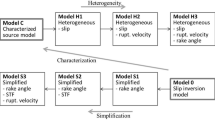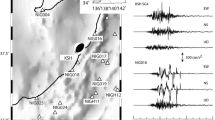Abstract
The seismic records acquired during the 1994 MW6.7 Northridge earthquake provide important data for studying the pulse-like ground motions in the vicinity of reverse faults. We selected 106 horizontal records from 468 strong ground motion records in the near-field region and rotated the original records into fault-parallel and fault-normal orientations. Large velocity pulses were simulated by the 3D finite difference method using a kinematic source model and a velocity structure model. Regression analysis was performed on the simulated and observed amplitudes of the velocity time history and response spectrum using the least-squares method. Our results show that the released energy and rupture time of asperities in the source model have important effects on the near-field velocity pulses, and the asperity near the initial rupture contributes more to the velocity pulses than does the asperity near the central region. The unidirectional and bidirectional characteristics of large velocity pulses are related to the thrust slip and rupture direction of the fault. The pulse period and the characteristic period are positively correlated with the rise time, and the pulse peak is regulated by multiple parameters of the subfaults. The distributions of the simulated PGV and Arias intensity agree well with the observed records, in which the contours exhibit asymmetric distribution and irregular elliptical attenuation in the near-field region, and the distributions exhibit a significant directivity along the fault. Moreover, the attenuation rate decreases with increasing distance from the fault. In addition, the fault-normal component is larger than that on the fault-parallel component, and the former decays faster. Velocity pulses larger than 30 cm/s are most likely to be distributed within approximately 15 km from the fault plane of the Northridge earthquake. Thus, the revealed pattern of the near-field velocity pulse-like ground motions indicates their close relation with the most severe earthquake effects.












Similar content being viewed by others
References
Aki K (1968) Seismic displacements near a fault. J Geophys Res 73(16):5359–5376
Aki K (1984) Asperities, barriers, characteristic earthquakes and strong motion prediction. J Geophys Res Solid Earth 89(B7):5867–5872
Aoi S, Fujiwara H (1999) 3D finite difference method using discontinuous grids. Bull Seismol Soc Am 89(4):918–930
Aoi S, Maeda T, Nishizawa N, Aoki T (2012) Large-scale ground motion simulation using GPGPU. AGU, fall meeting, S53G-06
Baker JW (2007) Quantitative classification of near-fault ground motions using wavelet analysis. Bull Seismol Soc Am 97(5):1486–1501
Beresnev IA, Atkinson GM (1998a) FINSIM-a FORTRAN program for simulating stochastic acceleration time histories from finite-faults. Seismol Res Lett 69(1):27–32
Beresnev IA, Atkinson GM (1998b) Stochastic finite-fault modeling of ground motions from the 1994 Northridge, California, earthquake. I. Validation on rock sites. Bull Seismol Soc Am 88(6):1392–1401
Bertero VV, Mahin SA, Herrera RA (1978) Aseismic design implications of near-fault San Fernando earthquake records. Earthq Eng Struct D 6(1):31–42
Boore DM (2003) Simulation of ground motion using the stochastic method. Pure Appl Geophys 160(3–4):635–676
Choudhury P, Chopra S, Roy KS, Sharma J (2016) Ground motion modelling in the Gujarat region of Western India using empirical Green’s function approach. Tectonophysics 675:7–22
Dickinson BW, Gavin HP (2011) Parametric statistical generalization of uniform-hazard earthquake ground motions. J Struct Eng 137(3):410–422
Field EH, Zeng Y, Johnson PA, Beresnev IA (1998) Nonlinear sediment response during the 1994 Northridge earthquake: observations and finite source simulations. J Geophys Res Solid Earth 103(B11):26869–26883
Furumura T, Maeda T, Oba A (2019) Early forecast of long-period ground motions via data assimilation of observed ground motions and wave propagation simulations. Geophys Res Lett 46(1):138–147
Gao MT, Yu YX, Zhang XM, Wu J, Hu P, Ding YH (2002) Three-dimensional finite-difference simulations of ground motions in the Beijing area. Earthq Res Chin 18(4):356–364 (in Chinese)
Graves RW (1998) Three-dimensional finite-difference modeling of the San Andreas fault: source parameterization and ground-motion levels. Bull Seismol Soc Am 88(4):881–897
Hartzell S, Liu P, Mendoza C (1996) The 1994 Northridge, California, earthquake: investigation of rupture velocity, risetime, and high-frequency radiation. J Geophys Res Solid Earth 101(B9):20091–20108
Heaton TH, Hall JF, Wald DJ, Halling MW (1995) Response of high-rise and base-isolated buildings to a hypothetical Mw 7.0 blind thrust earthquake. Science 267(5195):206–211
Irikura K (1983) Semi-empirical estimation of strong ground motions during large earthquakes. Bull Disaster Prev Res Inst Kyoto Univ Jpn 33(2):63–104
Irikura K, Miyake H (2011) Recipe for predicting strong ground motion from crustal earthquake scenarios. Pure Appl Geophys 168(1–2):85–104
Iwaki A, Maeda T, Morikawa N, Miyake H, Fujiwara H (2016) Validation of the recipe for broadband ground-motion simulations of Japanese crustal earthquakes. Bull Seismol Soc Am 106(5):2214–2232
Ji C, Wald DJ, Helmberger DV (2002) Source description of the 1999 Hector Mine, California, earthquake, part I: wavelet domain inversion theory and resolution analysis. Bull Seismol Soc Am 92(4):1192–1207
Kamae K, Irikura K (1998) Source model of the 1995 Hyogo-ken Nanbu earthquake and simulation of near-source ground motion. Bull Seismol Soc Am 88(2):400–412
Kawase H, Aki K (1990) Topography effect at the critical SV-wave incidence: possible explanation of damage pattern by the Whittier Narrows, California, earthquake of 1 October 1987. Bull Seismol Soc Am 80(1):1–22
Kramer S (1996) Geotechical earthquake engineering. Prentice Hall, Upper Saddle River, NJ, pp 50–300
Li XX (2016) Study on extraction of the velocity pulse and effects of inclusion on ground motion. Institute of Engineering Mechanics, China Earthquake Administration, Beijing, pp 10–11 (in Chinese)
Li Z, Chen X, Gao M, Jiang H, Li T (2017) Simulating and analyzing engineering parameters of Kyushu earthquake, Japan, 1997, by empirical Green function method. J Seismol 21(2):367–384
Li Z, Gao M, Jiang H, Chen X, Li T, Zhao X (2018) Sensitivity analysis study of the source parameter uncertainty factors for predicting near-field strong ground motion. Acta Geophys 66(4):523–540
Liu T, Luan Y, Zhong W (2012) A numerical approach for modeling near-fault ground motion and its application in the 1994 Northridge earthquake. Soil Dyn Earthq Eng 34(1):52–61
Liu J, Zhang J, Sun Y, Zhao T (2016) Comparison of methods for seismic wavelet estimation. Prog Geophys 31(2):0723–0731 (in Chinese)
Li A, Liu Y, Dai F, Liu K, Wei M (2020) Continuum analysis of the structurally controlled displacements for large-scale underground caverns in bedded rock masses. Tunn Undergr Space Technol 97:103288
Luo Q, Chen X, Gao M, Li Z, Zhang Z, Zhou D (2019) Simulating the near-fault large velocity pulses of the Chi-Chi (MW 7.6) earthquake with kinematic model. J Seismol 23(1):25–38
Maeda T, Morikawa N, Iwaki A, Aoi S, Fujiwara H (2014) Simulation-based hazard assessment for long-period ground motions of the Nankai Trough megathrust earthquake. AGU, fall meeting, S31C-4438
Maeda T, Iwaki A, Morikawa N, Aoi S, Fujiwara H (2016) Seismic-hazard analysis of long-period ground motion of megathrust earthquakes in the Nankai trough based on 3D finite-difference simulation. Seismol Res Lett 87(6):1265–1273
Magistrale H, Kanamori H, Jones C (1992) Forward and inverse three-dimensional P wave velocity models of the southern California crust. J Geophys Res Solid Earth 97(B10):14115–14135
Malhotra PK (1999) Response of buildings to near-field pulse-like ground motions. Earthq Eng Struct D 28(11):1309–1326
Mavroeidis GP, Papageorgiou AS (2003) A mathematical representation of near-fault ground motions. Bull Seismol Soc Am 93(3):1099–1131
Mikumo T, Hirahara K, Miyatake T (1987) Dynamical fault rupture processes in heterogeneous media. Tectonophysics 144(1):19–36
Mori J, Wald DJ, Wesson RL (1995) Overlapping fault planes of the 1971 San Fernando and 1994 Northridge, California earthquakes. Geophys Res Lett 22(9):1033–1036
Motazedian D, Atkinson GM (2005) Stochastic finite-fault modeling based on a dynamic corner frequency. Bull Seismol Soc Am 95(3):995–1010
Murotani S, Miyake H, Koketsu K (2008) Scaling of characterized slip models for plate-boundary earthquakes. Earth Planets Space 60(9):987–991
Oglesby DD, Archuleta RJ (1997) A faulting model for the 1992 Petrolia earthquake: can extreme ground acceleration be a source effect? J Geophys Res Solid Earth 102(B6):11877–11897
Olsen KB, Day SM, Bradley CR (2003) Estimation of Q for long-period (> 2 sec) waves in the Los Angeles basin. Bull Seismol Soc Am 93(2):627–638
Olson AH, Orcutt JA, Frazier GA (1984) The discrete wavenumber/finite element method for synthetic seismograms. Geophys J Int 77(2):421–460
Pitarka A (1999) 3D elastic finite-difference modeling of seismic motion using staggered grids with nonuniform spacing. Bull Seismol Soc Am 89(1):54–68
Pu WC, Liang RJ, Dai FY, Huang B (2017) An analytical model for approximating pulse-like near-fault ground motions. J Vib Shock 36(4):208–213 (in Chinese)
Ricker N (1943) Further developments in the wavelet theory of seismogram structure. Bull Seismol Soc Am 33(3):197–228
Somerville P, Irikura K, Graves R, Sawada S, Wald D, Abrahamson N, Iwasaki Y, Kagawa T, Smith N, Kowada N (1999) Characterizing crustal earthquake slip models for the prediction of strong ground motion. Seismol Res Lett 70(1):59–80
Wald DJ, Heaton TH, Hudnut KW (1996) The slip history of the 1994 Northridge, California, earthquake determined from strong-motion, teleseismic, GPS, and leveling data. Bull Seismol Soc Am 86(1B):S49–S70
Wald DJ, Quitoriano V, Heaton TH, Kanamori H (1999) Relationships between peak ground acceleration, peak ground velocity, and modified Mercalli intensity in California. Earthq Spectra 15(3):557–564
Wang Y (2015) The Ricker wavelet and the Lambert W function. Geophys J Int 200(1):111–115
Xu LJ, Xie LL (2005) Characteristics of frequency content of near-fault ground motions during the Chi–Chi earthquake. Acta Seismol Sin 18(6):707–716 (in Chinese)
Zeng Y, Anderson JG (1996) A composite source model of the 1994 Northridge earthquake using genetic algorithms. Bull Seismol Soc Am 86(1B):S71–S83
Zhang WB, Yu XW (2010) Strong ground motion simulation of the 1999 Chi–Chi, Taiwan, earthquake. J Earthq Eng Eng Vib 30(3):1–11 (in Chinese)
Acknowledgements
The authors thank the financial support from the National Natural Science Foundation of China (No. 51779164) and the Youth Science and Technology Innovation Research Team Fund of Sichuan Province (2020JDTD0001). The strong motion records come from the Pacific Earthquake Engineering Research (PEER) Center NGA-West2 database. We appreciated the anonymous reviewer for their constructive comments and suggestions that greatly improve this manuscript.
Author information
Authors and Affiliations
Corresponding author
Rights and permissions
About this article
Cite this article
Luo, Q., Dai, F., Liu, Y. et al. Numerical modelling of the near-field velocity pulse-like ground motions of the Northridge earthquake. Acta Geophys. 68, 993–1006 (2020). https://doi.org/10.1007/s11600-020-00459-4
Received:
Accepted:
Published:
Issue Date:
DOI: https://doi.org/10.1007/s11600-020-00459-4




